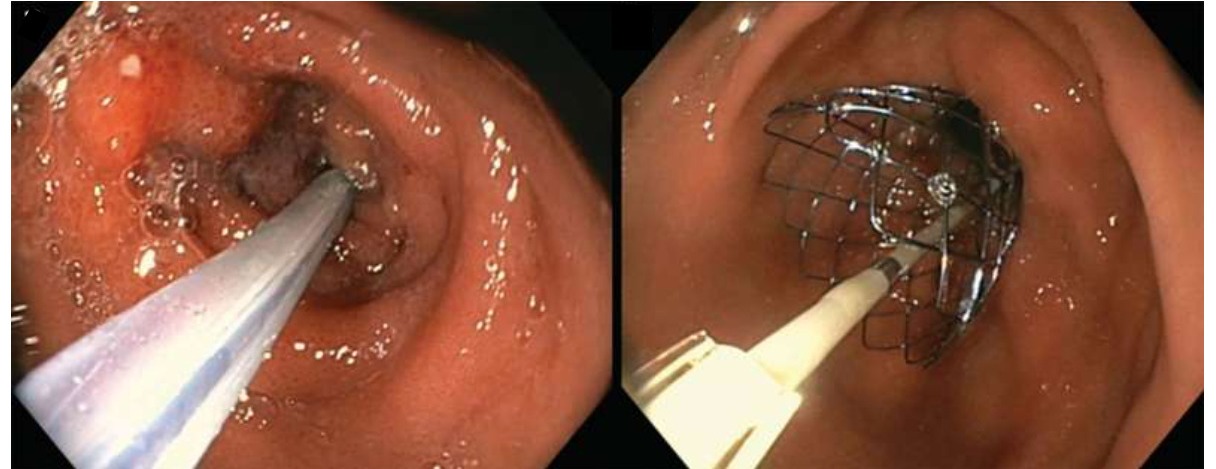Tuesday Poster Session
Category: Small Intestine
P4140 - Challenging Management of Unresectable Undifferentiated Osteoclast-Like Giant Cells Carcinoma of the Duodenum: A Case Report of Perforation Following Duodenal Stenting
Tuesday, October 24, 2023
10:30 AM - 4:00 PM PT
Location: Exhibit Hall

Has Audio

Manasik Abdu, MD
University at Buffalo-Catholic Health System
Buffalo, NY
Presenting Author(s)
Manasik Abdu, MD1, Debduti Mukhopadhyay, MD2, Anandita kishore, MD1, Fouad Jaber, MD3, Naren Nallapeta, MD4
1University at Buffalo-Catholic Health System, Buffalo, NY; 2UB, Buffalo, NY; 3University of Missouri-Kansas City, Kansas City, MO; 4UB Jacobs School of Medicine, Buffalo, NY
Introduction: Undifferentiated Osteoclast-like Giant Cells Carcinoma (OGCC) of the Duodenum is a rare and aggressive malignancy. Its exact incidence is difficult to determine due to limited data. Surgery is the primary treatment, but the prognosis remains poor. Duodenal stenting is used to relieve symptoms caused by duodenal obstruction, offering a minimally invasive option for palliation.
Case Description/Methods: In this case study, a 51-year-old male with a history of recurrent pancreatitis presented with epigastric and peri-umbilical pain that worsened with eating. Initial imaging revealed partial thrombosis of the superior mesenteric vein, and anticoagulation was not started. The patient was referred to the gastroenterology and surgical departments for further evaluation. Two months later, a follow-up CT scan showed the progression of the thrombus to the portal vein and splenic vein, leading to the initiation of Xarelto treatment.
Subsequently, the patient experienced coffee-ground emesis and imaging confirmed the presence of an ill-defined soft tissue mass in the duodenum, along with regional adenopathy. Biopsies revealed an undifferentiated carcinoma with osteoclast giant cells, OGCC, and the surgical team deemed the tumor unresectable. Treatment options including duodenal stenting and FOLFIRINOX were discussed, and the patient underwent duodenal stenting. Following the procedure, there was an initial improvement in nausea and vomiting, and the patient's diet was gradually advanced.
However, a week after the stent placement, the patient's condition deteriorated rapidly. Imaging showed free fluid adjacent to the stent and the development of multiple foci of free intraperitoneal air, indicating a perforation of the duodenum. Despite the option of emergent surgery, the patient declined and chose comfort care. Unfortunately, the patient passed away three days later.
Discussion: OGCC of the Duodenum is a rare and aggressive malignancy, accounting for only a small proportion of duodenal malignancies. While the exact incidence remains uncertain, it poses significant challenges in diagnosis and treatment. Duodenal stenting emerges as a valuable approach to alleviate symptoms and support nutrition in cases of OGCC-related duodenal obstruction. However, further research is needed to determine the most effective management strategies for this rare disease, assess the long-term outcomes of duodenal stenting, and ensure awareness of potential complications associated with the procedure.

Disclosures:
Manasik Abdu, MD1, Debduti Mukhopadhyay, MD2, Anandita kishore, MD1, Fouad Jaber, MD3, Naren Nallapeta, MD4. P4140 - Challenging Management of Unresectable Undifferentiated Osteoclast-Like Giant Cells Carcinoma of the Duodenum: A Case Report of Perforation Following Duodenal Stenting, ACG 2023 Annual Scientific Meeting Abstracts. Vancouver, BC, Canada: American College of Gastroenterology.
1University at Buffalo-Catholic Health System, Buffalo, NY; 2UB, Buffalo, NY; 3University of Missouri-Kansas City, Kansas City, MO; 4UB Jacobs School of Medicine, Buffalo, NY
Introduction: Undifferentiated Osteoclast-like Giant Cells Carcinoma (OGCC) of the Duodenum is a rare and aggressive malignancy. Its exact incidence is difficult to determine due to limited data. Surgery is the primary treatment, but the prognosis remains poor. Duodenal stenting is used to relieve symptoms caused by duodenal obstruction, offering a minimally invasive option for palliation.
Case Description/Methods: In this case study, a 51-year-old male with a history of recurrent pancreatitis presented with epigastric and peri-umbilical pain that worsened with eating. Initial imaging revealed partial thrombosis of the superior mesenteric vein, and anticoagulation was not started. The patient was referred to the gastroenterology and surgical departments for further evaluation. Two months later, a follow-up CT scan showed the progression of the thrombus to the portal vein and splenic vein, leading to the initiation of Xarelto treatment.
Subsequently, the patient experienced coffee-ground emesis and imaging confirmed the presence of an ill-defined soft tissue mass in the duodenum, along with regional adenopathy. Biopsies revealed an undifferentiated carcinoma with osteoclast giant cells, OGCC, and the surgical team deemed the tumor unresectable. Treatment options including duodenal stenting and FOLFIRINOX were discussed, and the patient underwent duodenal stenting. Following the procedure, there was an initial improvement in nausea and vomiting, and the patient's diet was gradually advanced.
However, a week after the stent placement, the patient's condition deteriorated rapidly. Imaging showed free fluid adjacent to the stent and the development of multiple foci of free intraperitoneal air, indicating a perforation of the duodenum. Despite the option of emergent surgery, the patient declined and chose comfort care. Unfortunately, the patient passed away three days later.
Discussion: OGCC of the Duodenum is a rare and aggressive malignancy, accounting for only a small proportion of duodenal malignancies. While the exact incidence remains uncertain, it poses significant challenges in diagnosis and treatment. Duodenal stenting emerges as a valuable approach to alleviate symptoms and support nutrition in cases of OGCC-related duodenal obstruction. However, further research is needed to determine the most effective management strategies for this rare disease, assess the long-term outcomes of duodenal stenting, and ensure awareness of potential complications associated with the procedure.

Figure: Duodenal Stent Placement During Upper Endoscopy
Disclosures:
Manasik Abdu indicated no relevant financial relationships.
Debduti Mukhopadhyay indicated no relevant financial relationships.
Anandita kishore indicated no relevant financial relationships.
Fouad Jaber indicated no relevant financial relationships.
Naren Nallapeta indicated no relevant financial relationships.
Manasik Abdu, MD1, Debduti Mukhopadhyay, MD2, Anandita kishore, MD1, Fouad Jaber, MD3, Naren Nallapeta, MD4. P4140 - Challenging Management of Unresectable Undifferentiated Osteoclast-Like Giant Cells Carcinoma of the Duodenum: A Case Report of Perforation Following Duodenal Stenting, ACG 2023 Annual Scientific Meeting Abstracts. Vancouver, BC, Canada: American College of Gastroenterology.
